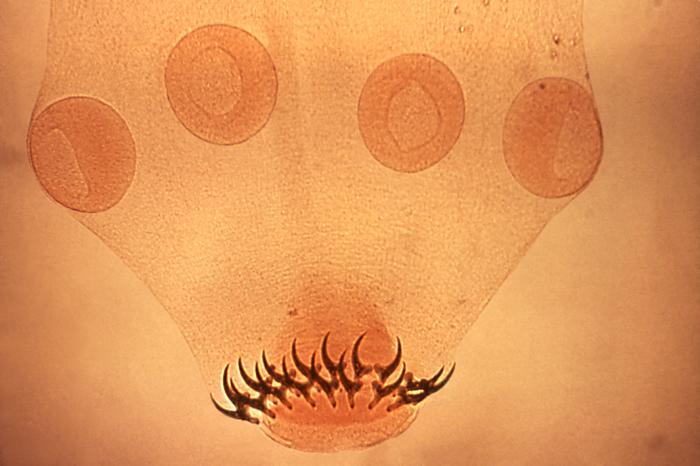Playlist
Show Playlist
Hide Playlist
Taenia (Cestodes) – Helminths
00:01 Taenia, parasites. 00:03 The taenia come from the genus of cestoda class and they are far more worm-like than just a parasite and hence they are called helminthic parasite, a worm like parasite, and as you can see in the picture in front of you, they indeed have that appearance. 00:20 The taenia have a ribbon like segmented body, in fact, as we'll see later, many of them appear as tapeworms when they are full grown. 00:30 The anterior end, the scolex is armed with suckers and hooks and you can see that on the right side of the image in front of you. 00:39 The taenia have several members which are human pathogens and they are taenia solium, taenia saginata and taenia asiatica and yet another beautiful picture of them right in front of you, very specially showing the hooks at the scolex end. 00:58 It’s probably best to understand the impact of the taenia by comparing and contrasting the two primary diseases and those are taeniasis or intestinal tapeworm and cycticercosis. 01:13 Looking first at taeniasis, the intestinal tapeworm, this comes from ingesting of larvae encysted in undercooked pork or beef, so larvae, not the eggs but the larvae and this is most often the taenia seginata and occasionally the asiatica depending on what part of the country you are. 01:33 In cysticercosis, this comes from ingestion of these eggs, so not the larvae but even earlier in life cycle the eggs in contaminated food and this comes from taenia solium. 01:46 Incubation for both of these is probably a very long time but it’s hard to tell without knowing when exact ingestion occurred of either the larvae or the eggs, but it is safe to assume that the process is asymptomatic for a long time. 02:04 During that time, in the case of intestinal tapeworm, the taeniasis, the larvae are now entering to the intestine where they are attaching to the cell wall and they are growing into adult worms. 02:18 In the case of cysticercosis during that asymptomatic incubation time, the eggs are travelling and turning into larvae which are gaining access to the central nervous system, to the eyes, and to muscles where they will start to encyst themselves to cover themselves in cyst and lay quiet waiting for the next step. 02:40 What is that next step? Well, in the case of taeniasis, intestinal tapeworm, it is ongoing sucking of blood and other nutrients by the adult worms attached to the intestinal mucosa and so as you can imagine patients will likely become slowly and progressively anemic and they may have failure to thrive. 03:02 In the case of cysticercosis, nothings happens until those larvae, while waiting for the next step which never comes start to die. The dead larvae within the cyst then releases antigen which creates an intense and relatively immediate human immune reaction which can occur within the brain, within the eyes, within muscles, all of which will create as you can imagine lots of clinical symptoms. 03:30 So what then are the clinical manifestations? For taeniasis, intestinal tapeworm, abdominal pain as you would imagine, diarrhea probably coming in some regard as a malabsorptive diarrhea. 03:43 The weight loss I’ve mentioned before certainly any signs you can imagine for intestinal irritation such as nausea, such as sometimes emesis, even just indigestion, that sense of not well-being and most importantly anemia, in fact most cases of intestinal tapeworm go unrecognized until the patient comes in with clinical signs of anemia such as weakness, exercise intolerance, shortness of breath, paleness - you name it. 04:14 For cysticercosis when those freshly formed larvae in their cyst die and create the inflammatory reaction they may cause blindness if they occur in the eye. 04:26 They may cause seizures if they occur in the head, they may certainly cause headaches. 04:30 If they die in the muscles they’ll cause myocitis - all of these reactions will cause fever and an eosinophilic response because these antigens are actually triggering not just an inflammatory reaction but an eosinophilic or allergic inflammatory reaction. 04:47 One even can see a subcutaneous cyst on the trunks and the limbs. 04:51 Of these two, as you can imagine, the most life threatening part will be the cysticercosis. 04:58 Treatment then for either of these possibilities is typically going to be a combination of drugs any one or two of which you see in front of you, so niclosamide, praziquantel, albendazole. 05:12 The albendazole and mebendazole, two sister drugs in the same family are the most often used start off with because they are anthelmintic, anti-worm and again, the behavior of whether it’s the tapeworm or the cysticercosis is most like that of a worm. 05:32 So the taenia, a parasite which depending on what type you were infected and afflicted with has many and multiple different types of pathology but in the end it’s all just nasty.
About the Lecture
The lecture Taenia (Cestodes) – Helminths by Sean Elliott, MD is from the course Parasites.
Included Quiz Questions
For the parasite Taenia saginata, the term Cestoda refers to its...?
- ...class.
- ...phylum.
- ...genus.
- ...order.
- ...family.
Ingesting a parasitic helminth in which of the following lifecycle stages is most likely to present as a brain abscess?
- Egg
- Encysted larva
- Adult worm
- Oncosphere
- Cysticercus
Which of the following terms best describes the anterior end of an adult tapeworm that has hooks or suckers for attachment?
- Scolex
- Mature proglottid
- Immature proglottid
- Rostellum
- Strobilus
Customer reviews
5,0 of 5 stars
| 5 Stars |
|
5 |
| 4 Stars |
|
0 |
| 3 Stars |
|
0 |
| 2 Stars |
|
0 |
| 1 Star |
|
0 |




